Quantitative Analysis of Anthropogenic Morphologies Based on Multi-Temporal High-Resolution Topography
Abstract
:1. Introduction
2. Study Area
3. Method
3.1. Slope Local Length of Auto-Correlation (SLLAC)
3.2. DEM of Difference (DoD)
3.3. Spatial Autocorrelation
3.4. The Workflow of the Method
- Natural reserves should be characterized by high disorganization of slope (the presence of vegetation on a LiDAR DTM will still leave a rougher surface the denser the vegetation is, due to the number of pulses that can penetrate the canopy). As a consequence, the topography should be characterized by high Spc and medium to low
- Plantations should be characterized by similar patterns of the slope, but with a higher degree of organization, since plant location is specifically designed through projects and species selections. Consequently, topographies under plantations should be characterized by medium values of Spc and low ;
- Moving towards more ‘artificial’ landscapes, agricultural areas should be characterized by medium Spc values, but high , since the landscape would be mostly flat or ‘flattened’ to allow for machinery access;
- Urban areas are likely to be self-similar at distances shorter than that of agricultural areas, and they would display a much higher degree of organization in the landscape than a natural landscape. As a consequence, they should be characterized by a low Spc and medium to high ;
- Open-pit mining is characterized by long terraces; therefore, the topography for these areas should be characterized by medium Spc and the medium .
4. Results
4.1. Test Hypotheses in the 5 Case Studies
4.2. Test Hypotheses in the Whole Basin
4.3. Quantitative Detection of the Geomorphic Changes
5. Discussion
6. Conclusions
Author Contributions
Funding
Acknowledgments
Conflicts of Interest
References
- Tarolli, P.; Sofia, G. Human topographic signatures and derived geomorphic processes across landscapes. Geomorphology 2016, 255, 140–161. [Google Scholar] [CrossRef] [Green Version]
- Wohl, E. Wilderness is dead: Whither critical zone studies and geomorphology in the Anthropocene? Anthropocene 2013, 2, 4–15. [Google Scholar] [CrossRef]
- Tarolli, P. Humans and the Earth’s surface. Earth Surf. Process. Landf. 2016, 41, 2301–2304. [Google Scholar] [CrossRef]
- Hilborn, R. Moving to sustainability by learning from successful fisheries. Ambio 2007, 36, 296–303. [Google Scholar] [CrossRef]
- García-Ruiz, J.M.; Beguería, S.; Nadal-Romero, E.; González-Hidalgo, J.C.; Lana-Renault, N.; Sanjuán, Y. A meta-analysis of soil erosion rates across the world. Geomorphology 2015, 239, 160–173. [Google Scholar] [CrossRef] [Green Version]
- Tarolli, P.; Sofia, G.; Wenfang, C. The Geomorphology of the Human Age. Encycl. Anthr. 2018, 1, 35–43. [Google Scholar]
- Jordan, H.; Hamilton, K.; Lawley, R.; Price, S.J. Anthropogenic contribution to the geological and geomorphological record: A case study from Great Yarmouth, Norfolk, UK. Geomorphology 2016, 253, 534–546. [Google Scholar] [CrossRef]
- Passalacqua, P.; Belmont, P.; Staley, D.M.; Simley, J.D.; Arrowsmith, J.R.; Bode, C.A.; Crosby, C.; DeLong, S.B.; Glenn, N.F.; Kelly, S.A.; et al. Analyzing high resolution topography for advancing the understanding of mass and energy transfer through landscapes: A review. Earth Sci. Rev. 2015, 148, 174–193. [Google Scholar] [CrossRef] [Green Version]
- Tarolli, P. High-resolution topography for understanding Earth surface processes: Opportunities and challenges. Geomorphology 2014, 216, 295–312. [Google Scholar] [CrossRef]
- Sofia, G.; Marinello, F.; Tarolli, P. Metrics for quantifying anthropogenic impacts on geomorphology: Road networks. Earth Surf. Process. Landf. 2016, 41, 240–255. [Google Scholar] [CrossRef]
- Williams, R.D. DEMs of Difference. Geomorphol. Tech. 2012, 2, 1–17. [Google Scholar]
- Wheaton, J.M.; Brasington, J.; Darby, S.E.; Sear, D.A. Accounting for uncertainty in DEMs from repeat topographic surveys: Improved sediment budgets. Earth Surf. Process. Landf. 2010, 35, 136–156. [Google Scholar] [CrossRef]
- Lane, S.N.; Richards, K.S.; Chandler, J.H. Developments in monitoring and modelling small-scale river bed topography. Earth Surf. Process. Landf. 1994, 19, 349–368. [Google Scholar] [CrossRef]
- Brasington, J.; Rumsby, B.T.; McVey, R.A. Monitoring and modelling morphological change in a braided gravel-bed river using high resolution GPS-based survey. Earth Surf. Process. Landf. 2000, 25, 973–990. [Google Scholar] [CrossRef]
- Westaway, R.M.; Lane, S.N.; Hicks, D.M. The development of an automated correction procedure for digital photogrammetry for the study of wide, shallow, gravel-bed rivers. Earth Surf. Process. Landf. 2000, 25, 209–226. [Google Scholar] [CrossRef]
- Prosdocimi, M.; Calligaro, S.; Sofia, G.; Dalla Fontana, G.; Tarolli, P. Bank erosion in agricultural drainage networks: New challenges from structure-from-motion photogrammetry for post-event analysis. Earth Surf. Process. Landf. 2015, 40, 1891–1906. [Google Scholar] [CrossRef]
- Brasington, J.; Langham, J.; Rumsby, B. Methodological sensitivity of morphometric estimates of coarse fluvial sediment transport. Geomorphology 2003, 53, 299–316. [Google Scholar] [CrossRef]
- Vericat, D.; Wheaton, J.M.; Brasington, J. Revisiting the morphological appoach: Opportunities and challenges with repeat high resolution topography. Gbr8 2015, 1–45. [Google Scholar]
- Sofia, G.; Marinello, F.; Tarolli, P. A new landscape metric for the identification of terraced sites: The Slope Local Length of Auto-Correlation (SLLAC). ISPRS J. Photogramm. Remote Sens. 2014, 96, 123–133. [Google Scholar] [CrossRef]
- Corcoran, P.; Mooney, P.; Bertolotto, M. Analysing the growth of OpenStreetMap networks. Spat. Stat. 2013, 3, 21–32. [Google Scholar] [CrossRef] [Green Version]
- Neis, P.; Zielstra, D. Recent Developments and Future Trends in Volunteered Geographic Information Research: The Case of OpenStreetMap. Future Internet 2014, 6, 76–106. [Google Scholar] [CrossRef] [Green Version]
- Neis, P.; Zipf, A. Analyzing the contributor activity of a volunteered geographic information project—The case of OpenStreetMap. ISPRS Int. J. Geo-Inf. 2012, 1, 146–165. [Google Scholar] [CrossRef]
- Haklay, M. How good is volunteered geographical information? A comparative study of OpenStreetMap and Ordnance Survey datasets. Environ. Plan. B Plan. Des. 2010, 37, 682–703. [Google Scholar] [CrossRef]
- Lin, Y. A qualitative enquiry into OpenStreetMap making. New Rev. Hypermedia Multimed. 2011, 17, 53–71. [Google Scholar] [CrossRef]
- Passalacqua, P.; Belmont, P.; Foufoula-Georgiou, E. Automatic geomorphic feature extraction from lidar in flat and engineered landscapes. Water Resour. Res. 2012, 48, 1–18. [Google Scholar] [CrossRef]
- Evans, I.S. An Integrated System of Terrain Analysis and Slope Mapping: Final Report on Grant DA-ERO-591-73-G0040; Durham University: Durham, UK, 1979. [Google Scholar]
- International Organization of Standardization (ISO). 25178-2:Geometrical Product Specifications (GPS)-Surface Texture: Areal-Part 2: Terms, Definitions and Surface Texture Parameters; ISO: Geneva, Switzerland, 2013. [Google Scholar]
- Chen, J.; Li, K.; Chang, K.J.; Sofia, G.; Tarolli, P. Open-pit mining geomorphic feature characterisation. Int. J. Appl. Earth Obs. Geoinf. 2015, 42, 76–86. [Google Scholar] [CrossRef]
- Tarolli, P.; Cao, W.; Sofia, G.; Evans, D.; Ellis, E.C. From features to fingerprints: A general diagnostic framework for anthropogenic geomorphology. Prog. Phys. Geogr. Earth Environ. 2019, 43, 95–128. [Google Scholar] [CrossRef] [Green Version]
- Sofia, G.; Masin, R.; Tarolli, P. Prospects for crowdsourced information on the geomorphic ‘engineering’ by the invasive Coypu (Myocastor coypus). Earth Surf. Process. Landf. 2017. [Google Scholar] [CrossRef]
- Moran, P.A.P. The interpretation of statistical maps. J. R. Stat. Soc. Ser. B 1948, 10, 243–251. [Google Scholar] [CrossRef]
- Sofia, G.; Tarolli, P. Automatic characterization of road networks under forest cover: Advances in the analysis of roads and geomorphic process interaction. Rend. Online Soc. Geol. Ital. 2016, 39, 23–26. [Google Scholar] [CrossRef]
- Steinhaus, H. Sur la division des corp materiels en parties. Bull. Acad. Pol. Sci 1956, 1, 801. [Google Scholar]
- Jain, A.K. Data clustering: 50 years beyond K-means. Pattern Recognit. Lett. 2010, 31, 651–666. [Google Scholar] [CrossRef]
- Arthur, D.; Vassilvitskii, S. K-Means++: The Advantages of Careful Seeding. Proc. Eighteenth Annu. ACM-SIAM Symp. Discret. Algorithms 2007, 8, 1025–1027. [Google Scholar] [CrossRef]
- Heipke, C.; Mayer, H.; Wiedemann, C.; Jamet, O. Automated reconstruction of topographic objects from aerial images using vectorized map information. Int. Arch. Photogramm. Remote Sens. 1997, 23, 47–56. [Google Scholar]
- Tarolli, P.; Sofia, G.; Dalla Fontana, G. Geomorphic features extraction from high-resolution topography: Landslide crowns and bank erosion. Nat. Hazards 2012, 61, 65–83. [Google Scholar] [CrossRef]
- Xiang, J.; Chen, J.; Sofia, G.; Tian, Y.; Tarolli, P. Open-pit mine geomorphic changes analysis using multi-temporal UAV survey. Environ. Earth Sci. 2018. [Google Scholar] [CrossRef]
- Forman, R.; Sperling, D.; Bissonette, J.; Clevenger, A.; Cutshall, C.; Dale, V.; Fahrig, L.; France, R.; Goldman, C.; Heanue, K.; et al. Road ecology: Science and solutions. Rev. Lit. Arts Am. 2003. [Google Scholar] [CrossRef]
- Ellis, E.C.; Ramankutty, N. Putting people in the map: Anthropogenic biomes of the world. Front. Ecol. Environ. 2008, 6, 439–447. [Google Scholar] [CrossRef]
- Daily, G.C.; Söderqvist, T.; Aniyar, S.; Arrow, K.; Dasgupta, P.; Ehrlich, P.R.; Folke, C.; Jansson, A.; Jansson, B.-O.; Kautsky, N.; et al. The Value of Nature and the Nature of Value. Science 2000, 289, 395–396. [Google Scholar] [CrossRef] [PubMed] [Green Version]
- Getis, A.; Ord, J.K. The analysis of spatial association by use of distance statistics. Geogr. Anal. 1992, 24, 189–206. [Google Scholar] [CrossRef]
- Hooke, R.L. On the history of humans as geomorphic agents. Geology 2000, 28, 843–846. [Google Scholar] [CrossRef]
- Fuller, I.C.; Macklin, M.G.; Richardson, J.M. The Geography of the Anthropocene in N ew Z ealand: Differential River Catchment Response to Human Impact. Geogr. Res. 2015, 53, 255–269. [Google Scholar] [CrossRef]
- Thomas, I.; Frankhauser, P.; Biernacki, C. The morphology of built-up landscapes in Wallonia (Belgium): A classification using fractal indices. Landsc. Urban Plan. 2008, 84, 99–115. [Google Scholar] [CrossRef]
- Beck, J.; Sieber, A. Is the Spatial Distribution of Mankind’s Most Basic Economic Traits Determined by Climate and Soil Alone? PLoS ONE 2010, 5, e10416. [Google Scholar] [CrossRef]
- Nolè, G.; Danese, M.; Murgante, B.; Lasaponara, R.; Lanorte, A. Using Spatial Autocorrelation Techniques and Multi-Temporal Satellite Data for Analyzing Urban Sprawl; Springer: Berlin/Heidelberg, Germany, 2012; pp. 512–527. [Google Scholar]
- Liu, J.; Chen, Y. Spatial autocorrelation and localization of urban development. Chin. Geogr. Sci. 2007, 17, 34–39. [Google Scholar] [CrossRef]
- Wilkinson, B.H. Humans as geologic agents: A deep-time perspective. Geology 2005, 33, 161–164. [Google Scholar] [CrossRef]
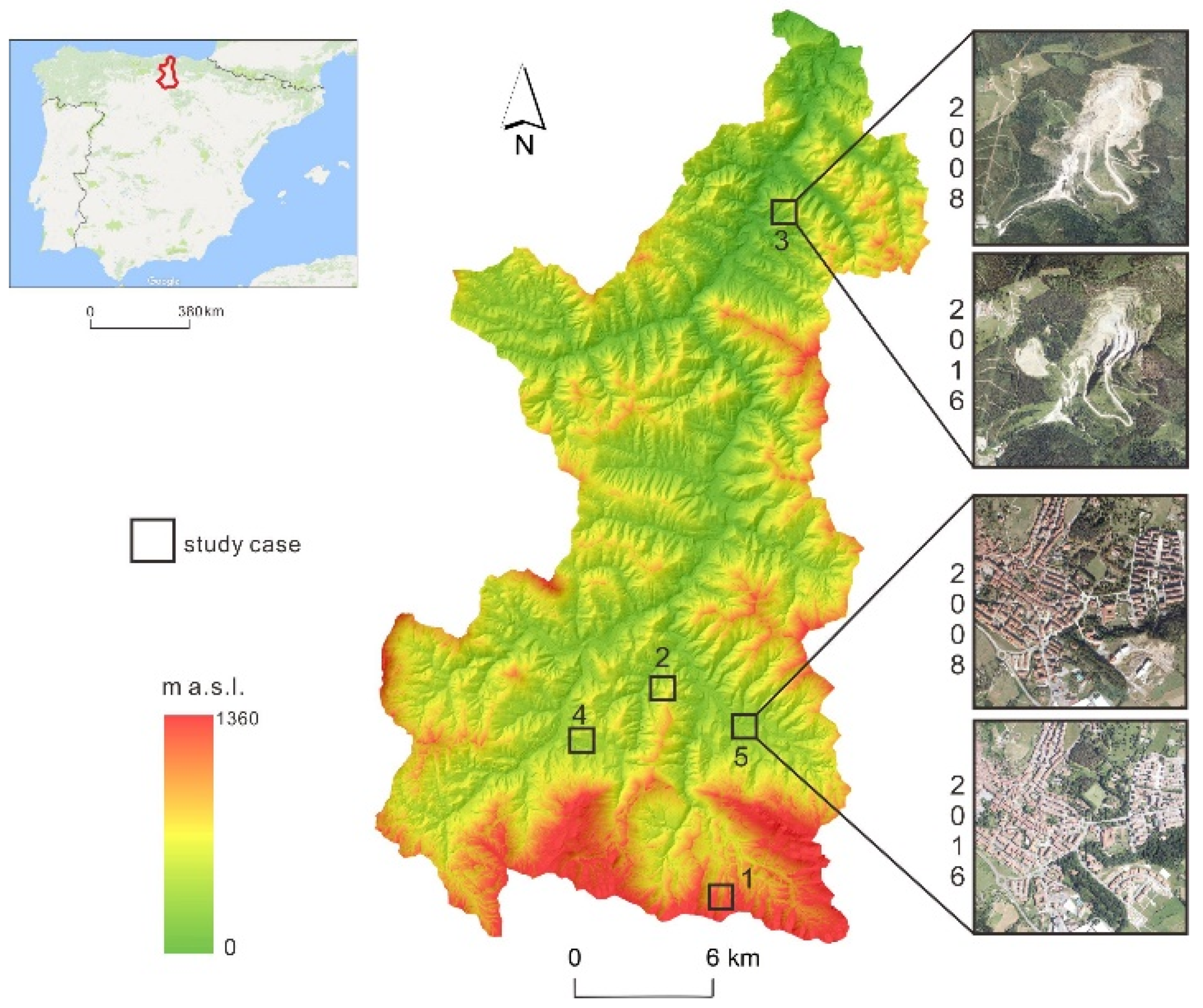

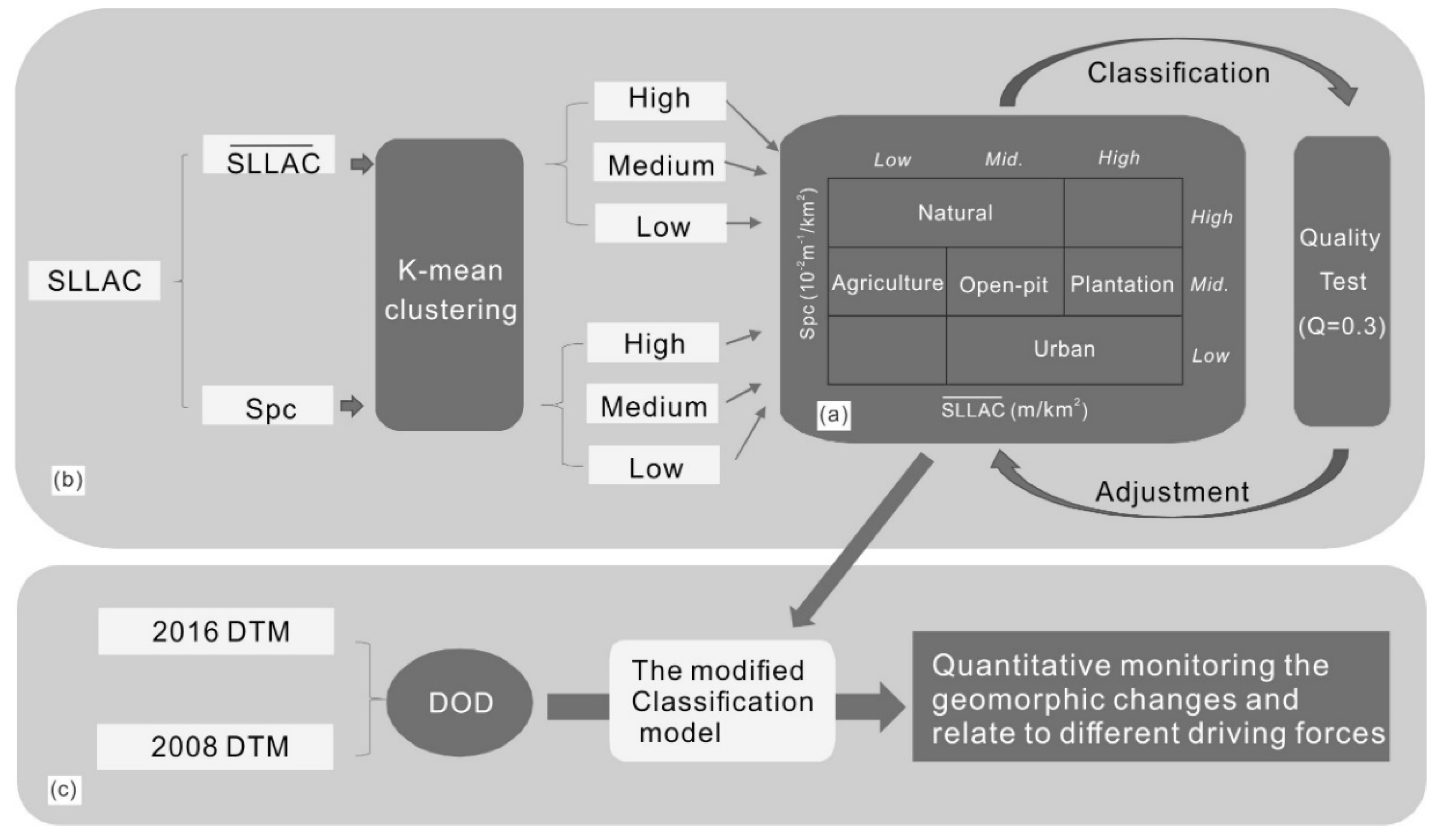



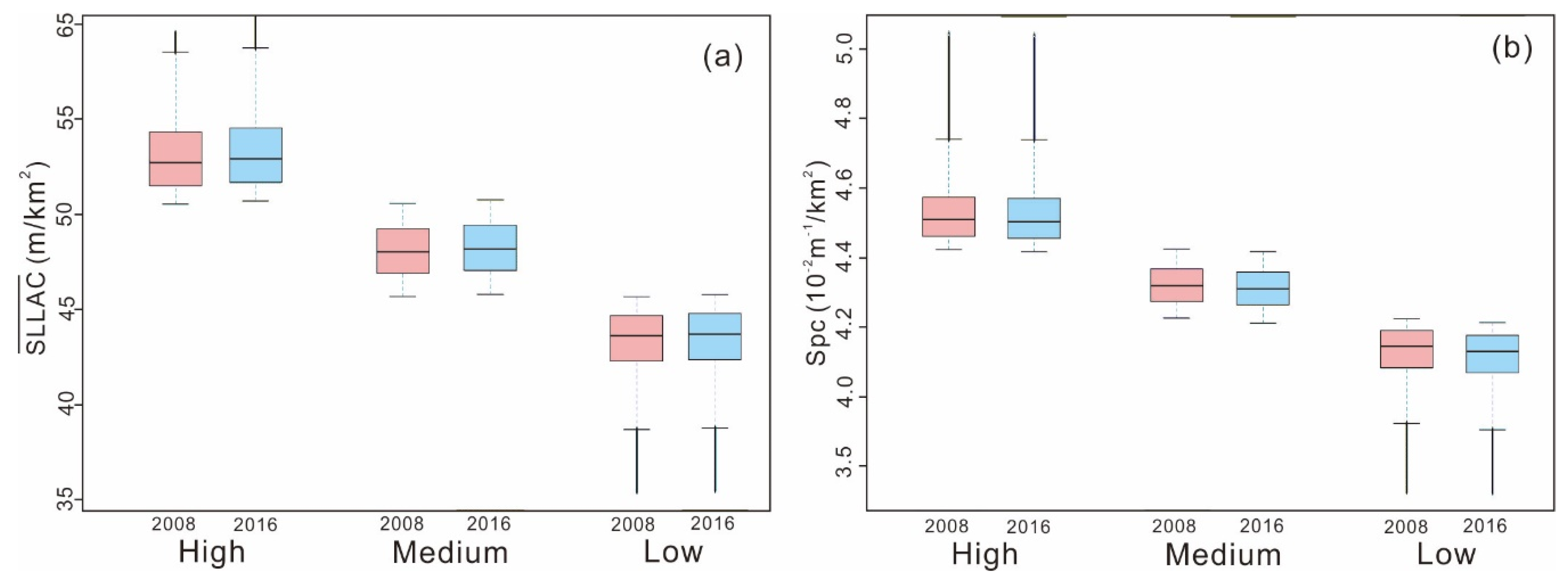
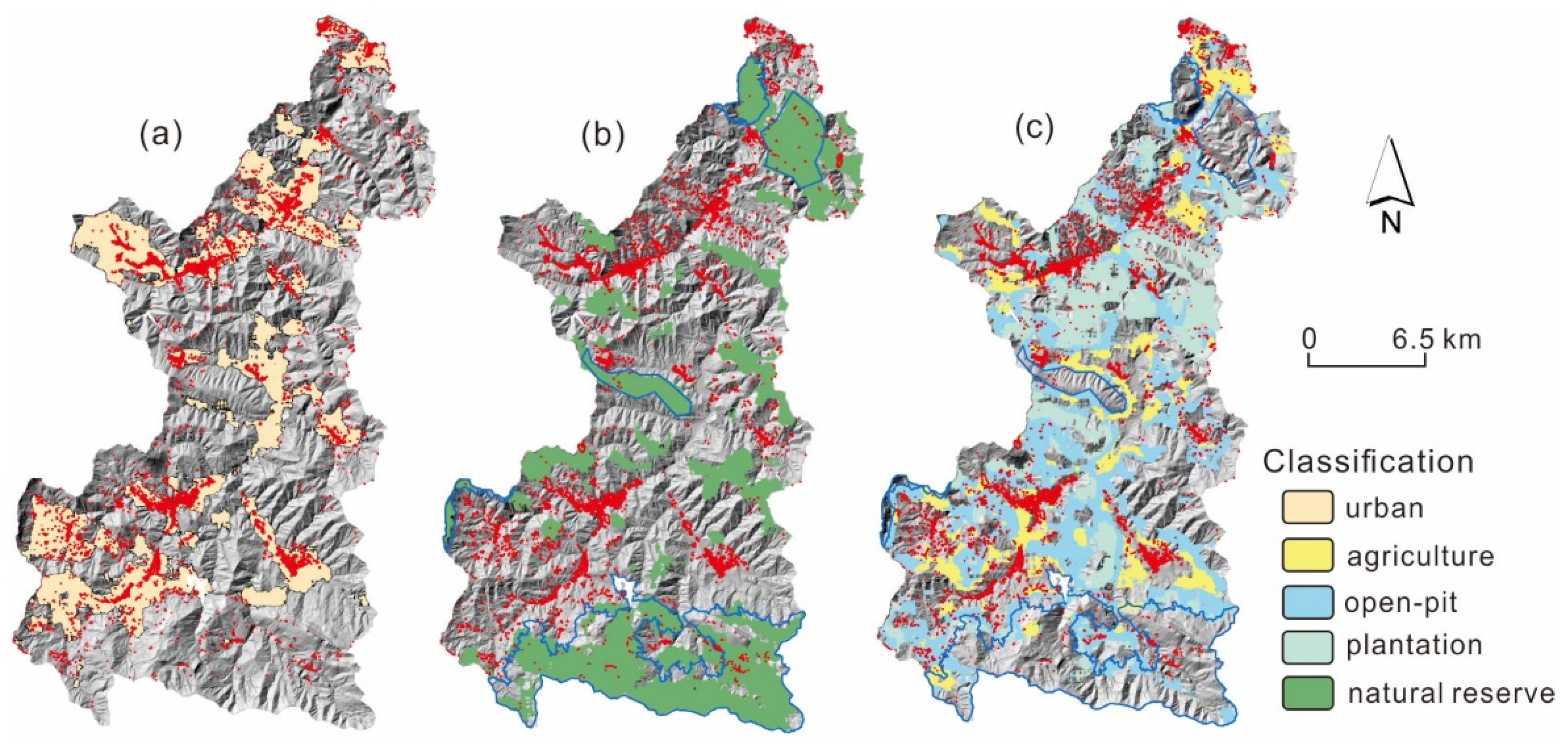
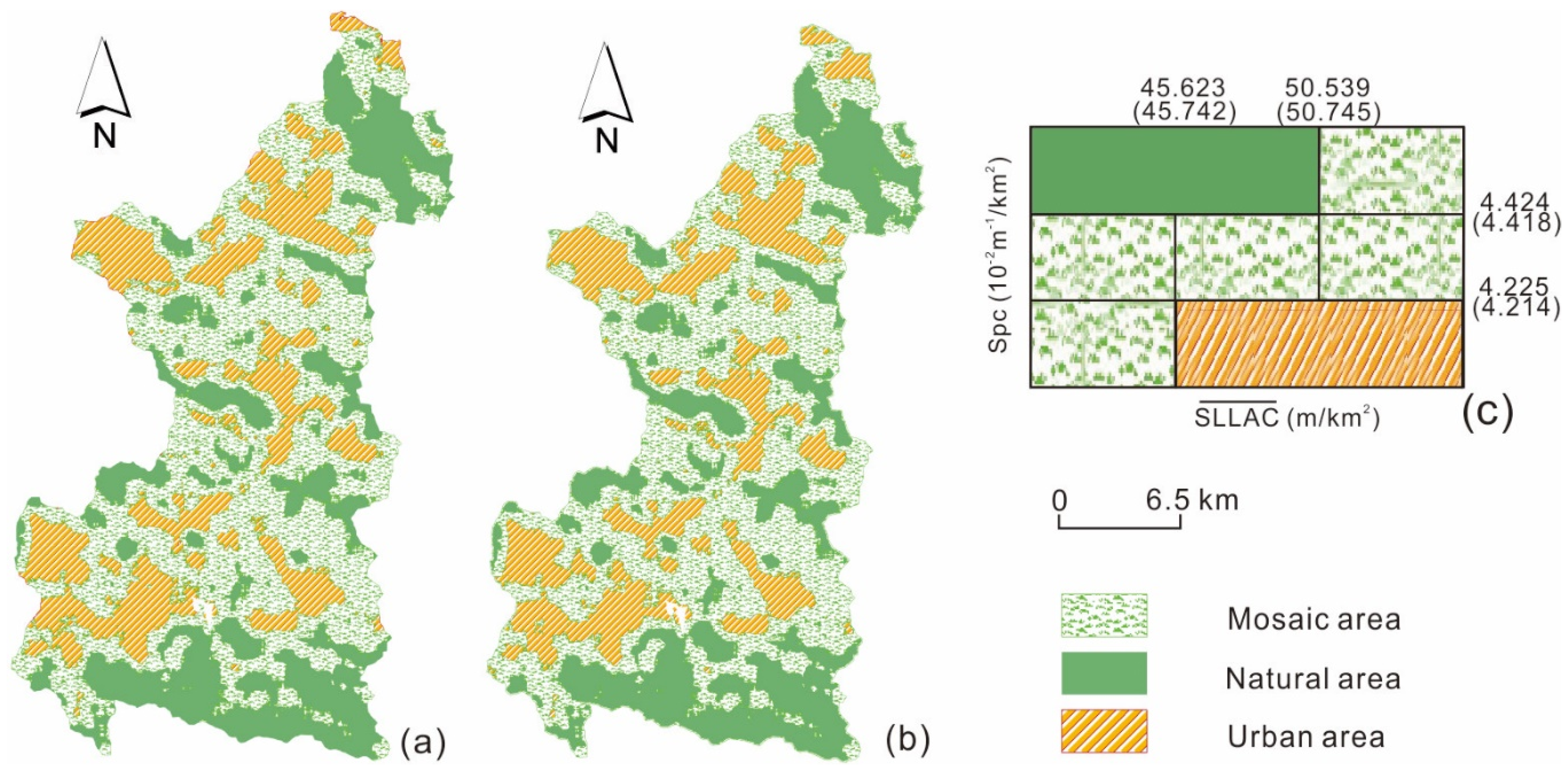
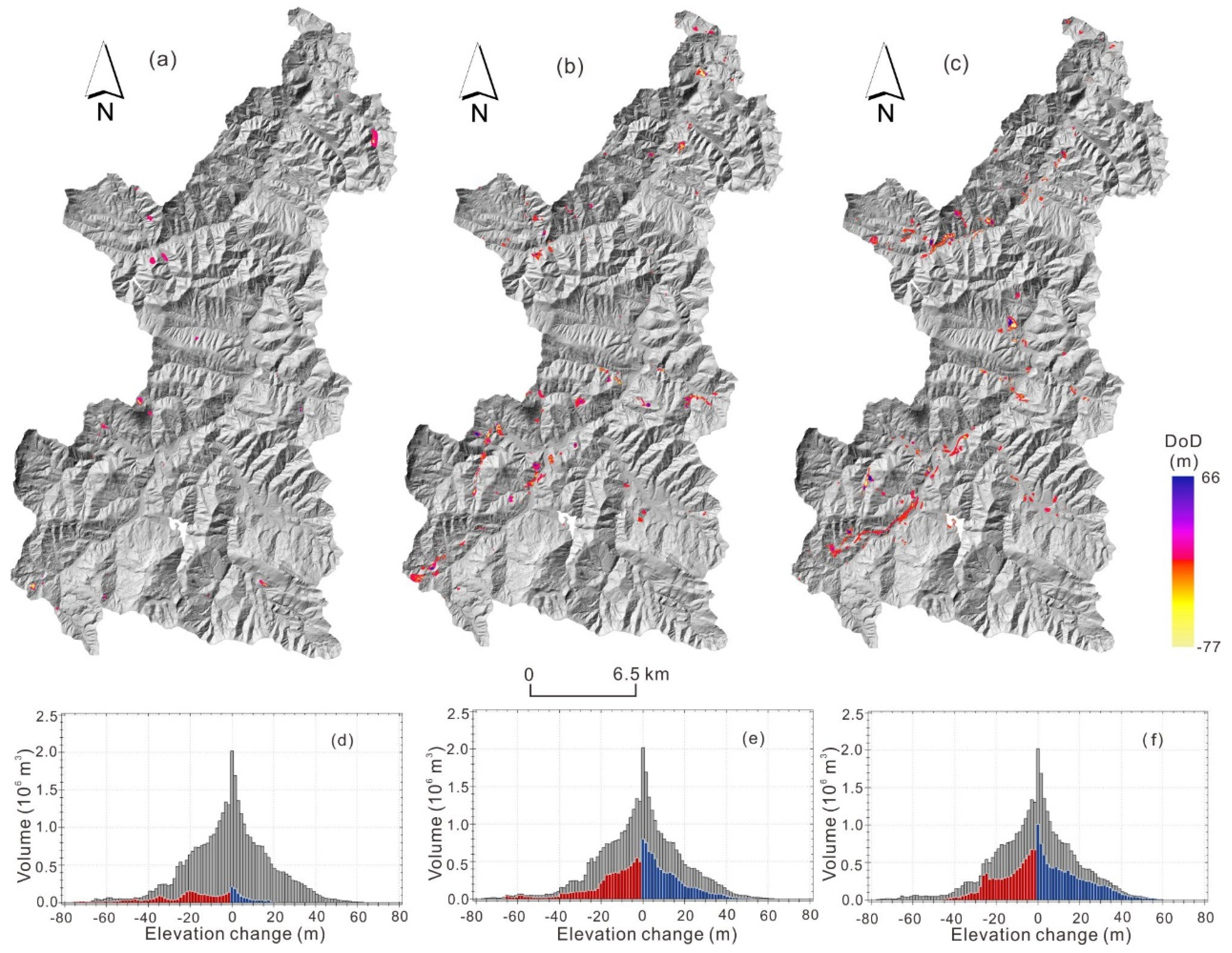
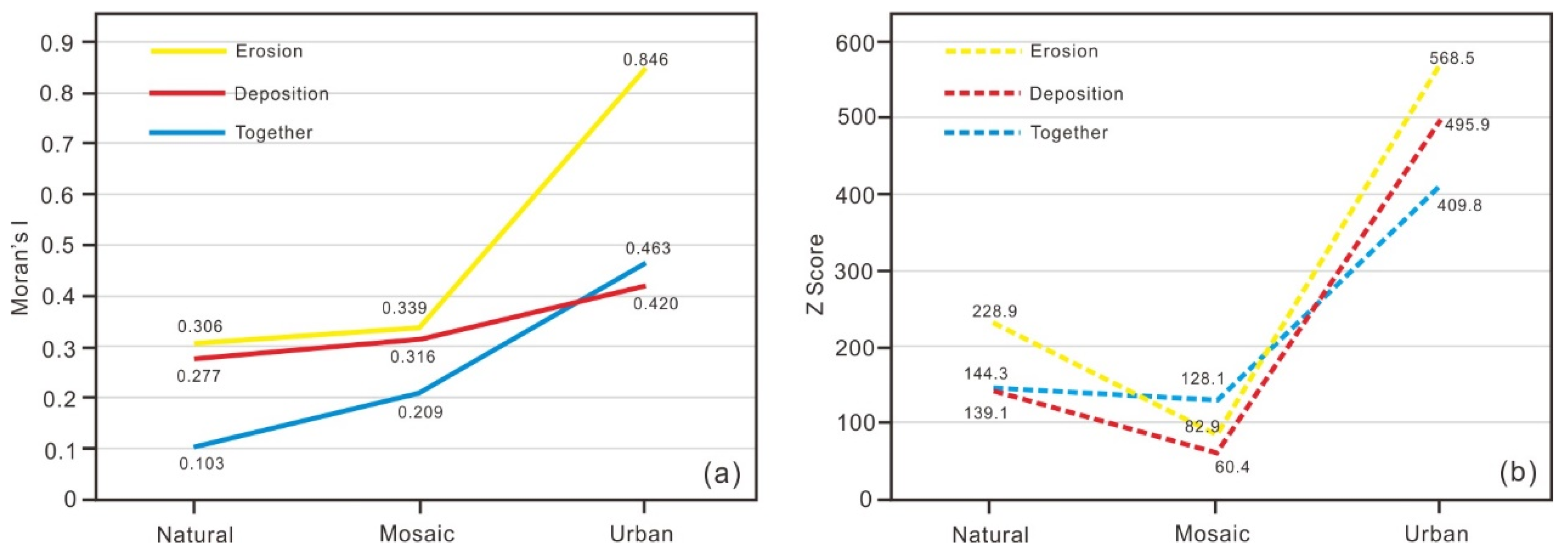
| Classification | Compared to Land-Use | Compared to UCI | ||
|---|---|---|---|---|
| Category | Quality | Range (pts/km2) | Quality | |
| Urban | residential | 0.37 | > 55 | 0.43 |
| Natural | natural park | 0.31 | < 5 | 0.30 |
| Agriculture | farmland | 0.11 | ||
| Open-pit | quarry | 0.05 | ||
| Plantation | woodland | 0.10 | ||
| Mosaic | farmland + quarry + woodland | 0.38 | [5, 50] | 0.36 |
| Classification | 2008 | 2016 | ||
|---|---|---|---|---|
| Area (km2) | Percentage (%) | Area (km2) | Percentage (%) | |
| Urban area | 120.92 | 23.66 | 122.64 | 24.00 |
| Mosaic area | 255.96 | 50.08 | 255.91 | 50.07 |
| Natural area | 134.24 | 26.26 | 132.56 | 25.93 |
| Artificial surface estimated from spc (10−2 m−1) | Spc = 4.325 | 25.84 | Spc = 4.319 | 26.26 |
| Erosion Area (km2) | Proportion of Erosion Area | Deposition Area (km2) | Proportion of Deposition Area | Erosion Volume (m3) | Deposition Volume (m3) | Total Net Volume (m3) | Erosion Rate (mm/yr) | |
|---|---|---|---|---|---|---|---|---|
| Natural area | 0.432 | 0.08% | 0.473 | 0.09% | 2,978,099 | 996,885 | -1,981,214 | 2.808 |
| (±61,098) | (±66,966) | (±90,650) | (±0.058) | |||||
| Mosaic area | 1.562 | 0.31% | 2.167 | 0.42% | 7,141,480 | 7,967,817 | 826,337 | 3.488 |
| (±220,922) | (±306,574) | (±377,882) | (±0.108) | |||||
| Urban area | 1.991 | 0.39% | 2.542 | 0.50% | 7,998,829 | 9,945,932 | 1,947,103 | 8.153 |
| (±281,601) | (±359,466) | (±456,635) | (±0.287) | |||||
| Whole basin | 3.985 | 0.78% | 5.183 | 1.01% | 18,118,408 | 18,910,636 | 792,228 | 4.339 |
| (±563,623) | (±733,007) | (±924,646) | (±0.135) |
© 2019 by the authors. Licensee MDPI, Basel, Switzerland. This article is an open access article distributed under the terms and conditions of the Creative Commons Attribution (CC BY) license (http://creativecommons.org/licenses/by/4.0/).
Share and Cite
Xiang, J.; Li, S.; Xiao, K.; Chen, J.; Sofia, G.; Tarolli, P. Quantitative Analysis of Anthropogenic Morphologies Based on Multi-Temporal High-Resolution Topography. Remote Sens. 2019, 11, 1493. https://doi.org/10.3390/rs11121493
Xiang J, Li S, Xiao K, Chen J, Sofia G, Tarolli P. Quantitative Analysis of Anthropogenic Morphologies Based on Multi-Temporal High-Resolution Topography. Remote Sensing. 2019; 11(12):1493. https://doi.org/10.3390/rs11121493
Chicago/Turabian StyleXiang, Jie, Shi Li, Keyan Xiao, Jianping Chen, Giulia Sofia, and Paolo Tarolli. 2019. "Quantitative Analysis of Anthropogenic Morphologies Based on Multi-Temporal High-Resolution Topography" Remote Sensing 11, no. 12: 1493. https://doi.org/10.3390/rs11121493






